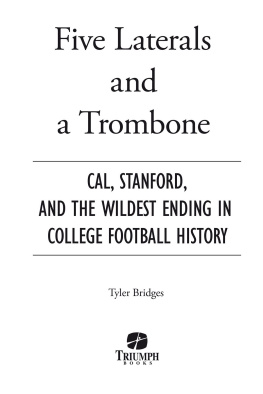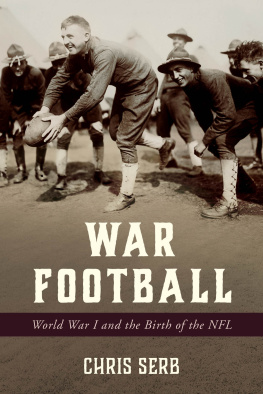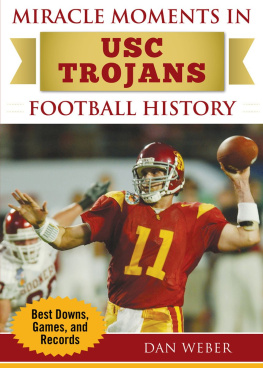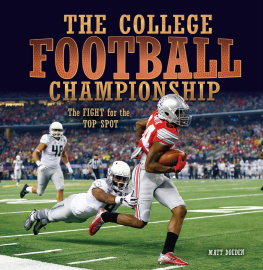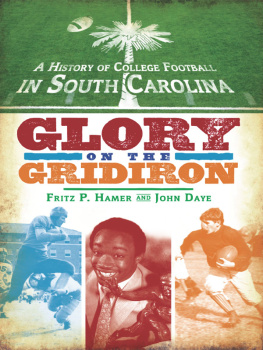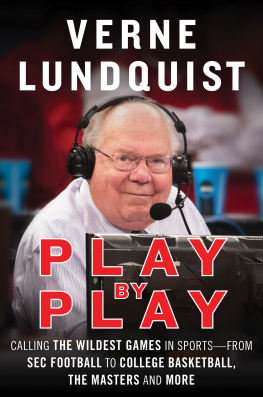No part of this publication may be reproduced, stored in a retrieval system, or transmitted in any form by any means, electronic, mechanical, photocopying, or otherwise, without the prior written permission of the publisher, Triumph Books LLC, 814 North Franklin Street, Chicago, Illinois 60610.
Library of Congress Cataloging-in-Publication Data available upon request.
This book is available in quantity at special discounts for your group or organization. For further information, contact:
Triumph Books LLC
814 North Franklin Street
Chicago, Illinois 60610
(312) 337-0747
www.triumphbooks.com
Printed in U.S.A.
To the 80,000 or so fans, players, band members, journalists, university employees, and others at the 1982 Big Game at Cals Memorial Stadium.
And to my late father Richard, a 1953 graduate of Stanfords law school, and to my daughter Luciana, who is scheduled to graduate from Stanford in 2024.
Foreword
As far back as I can remember, I liked to throw things. When I was a kid, I threw dirt clods and snowballs at telephone poles and cars. I graduated to throwing baseballs and footballs and shooting basketballs. However, as Tyler Bridges relates in Chapter Three, I didnt get to throw the ball much in ninth grade in Pullman, Washington, because our team ran the single-wing offense. Ive often wondered what would have happened if we hadnt moved to Granada Hills when my dad Jack was hired to be the head coach at Cal State Northridge. Jack Neumeier, my new coach at Granada Hills High School, ran an innovative offense that threw the ball on nearly every down. I was in heaven.
When I was a senior, I narrowed my choices to Stanford, USC, and San Jose State, where my dad then served as the head coach. I decided against USC, however, because they were Tailback U. From when my dad coached at Washington State, I had always wanted to play in the Pac-10. That gave Stanford an edge. But how could I say no to my dad at San Jose State? I idolized him, and he was my best friend. But my mom Jan intervened. She said I should go to Stanford because they offered such strong academics. My Stanford degree would help me whether or not I played professional sports, she said. Rod Dowhower, who had just replaced Bill Walsh as the head coach, said I could run Bills West Coast offense at Stanford. Jim Fassel, the offensive coordinator, was the closer. He said that Stanford was Quarterback U with all the great quarterbacks in recent yearsJim Plunkett, who won the Heisman, Mike Boryla, Guy Benjamin, Steve Dils, and Turk Schonert.
The thing I remember about Stanford is that students were as important as the athletes. Football interested the student body, but it wasnt the most important thing. The university really did make you be a part of the student body. I majored in economics and gained some of the tools and skills that helped me later with the restaurants and car dealerships that I now own.
At a lot of schools, the athletes get isolated by having their own living and eating facilities. That didnt happen at Stanford. I enjoyed playing footballand baseball during my freshman and sophomore yearsbut I also enjoyed being a student. It was nice to have the crossover. Thats part of whats great about the Stanford experience. You could play high-level football but also have the high-level experience of going to school there and being around quality people. I still look back at the guys I went to school withand its amazing the success theyve had.
The only disappointment was we didnt have the success we wanted to have on the field, though we won a lot of big games. The problem was we didnt play with a lot of consistency. Still, there were a lot of good football players, including running backs Mike Dotterer and Vincent White and several guys who made their mark in the NFL: tight end Chris Dressel, linebacker Garin Veris, linebacker Dave Wyman, and wide receiver Emile Harry. I still have good buddies that I was teammates withDennis Engel, Rob Moore, Ken Orvick, Don Lonsinger, Mike Tolliver, and Kenny Margerum are just a few of them.
Paul Wiggin, the head coach, was a good man who really cared about his players. Besides Fassel, several of our assistant coaches went on to become head coaches in the NFL: Denny Green, George Seifert, and Ray Handley. I was especially close with Fassel since he was the offensive coordinator. I give him a lot of credit for my success because of the techniques and discipline he taught me, including the precise steps to take while dropping back. Getting your footwork right is really important.
Tylers book, of course, focuses on the 1982 Big Game. First, let me say that Cal versus Stanford is one of the great all-time rivalries in college football. Its played every year, there are lots of traditions associated with it, and the two schools are only 40 miles apart.
I havent been able back to make it to the Bay Area for a Big Game in a long time. But even now, when I run into friends from Cal, I jokingly call them Dirty Golden Bears. Of course, they have a few choice names for me. Old traditions die hard! Jokes aside, its always been a respectful rivalry.
At the beginning of the season, we always circled that game on the schedule and wanted to win it and the Axe. We knew that winning the 1982 Big Game wouldnt be easy for us, of course. Gale Gilbert was on his way to becoming a top quarterback, and John Tuggle was a tough runner. I was most concerned with their defense, especially Rich Stachowski, Gary Plummer, and Reggie Camp on their front line. Ron Rivera at linebacker was their leading tackler, someone you had to pay attention to on every down. He was especially strong against the run, but he could also rush the passer and drop into coverage.
Winning the Big Game meant something extra in 1982 because if we won, wed go to the Hall of Fame Bowl. Back then, no matter what bowl you went to, it meant something because there were so few of them. Plus, if we lost, it would be my last collegiate game.
It was a typical hard-fought Big Game. Late in the contest, it looked like we were going to lose. We faced fourth and 17 on our own 13-yard line, were down by two points, and had only 53 seconds left. The odds were clearly not in our favor at that point. But I received great protection and was able to complete a pass to Emile that kept the drive alive. We kept the chains moving, and then Mark Harmon kicked what we thought was the game-winning field goal. We were so excited. We had beaten our big rival, and it also meant Id get to extend my college career and play with my buddies one more time in the bowl game.
And then one historic play took it all away from us. We couldnt believe it. We were stunned. Within a three-minute span, my teammates and I went from reaching the highest of highs to plunging to the lowest of lows. I never went through an emotional roller coaster like that in my entire career at Stanford or with the Denver Broncos. Still, time does heal wounds and provide perspective. Ive been fortunate enough to play in more Super Bowls than most. I guess it all evens out.
John Elway graduated from Stanford in 1983 as the NCAA career leader in completions and he was second in total offense and third in touchdown passes. The No. 1 pick in the 1983 NFL Draft, he went on to play 16 years for the Denver Broncos. After three losses in the Super Bowl, Elway capped his career by winning the NFL title in his final two seasons and was inducted into the Pro Football Hall of Fame in 2004. Elway served as the Broncos general manager for a decade, during which they won Super Bowl 50 against the Carolina Panthers.

